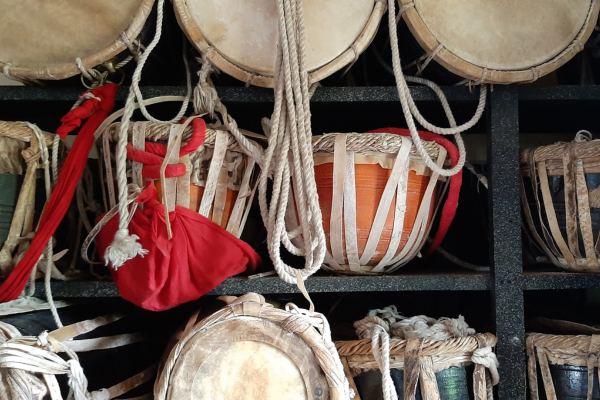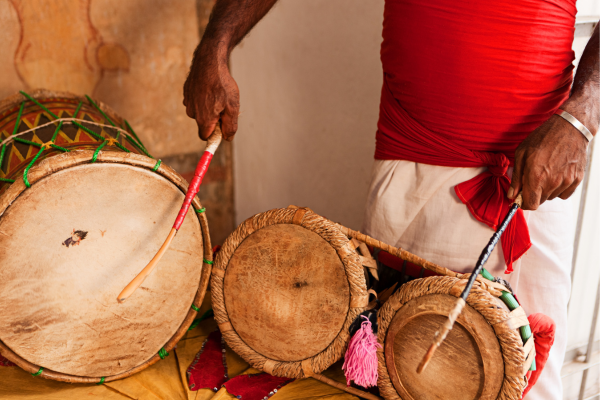most popular traditional drums in Sri Lanka – By Malsha – eLanka

Sri Lanka has a rich cultural heritage when it comes to traditional music and dance, and the use of drums plays a vital role in many of these art forms. Here are some of the most popular traditional drums in Sri Lanka:
- Geta Beraya: The Geta Beraya is a traditional drum that is often used in Kandyan dance performances. It is made of wood and has a cylindrical shape. The drum is played with two sticks, and its distinctive sound is said to mimic the sound of thunder.
- Yak Beraya: The Yak Beraya is another drum that is commonly used in Kandyan dance performances. It is also made of wood and has a cylindrical shape, but it is larger than the Geta Beraya. It is played with a single stick and produces a deep, resonant sound.
- Udakki: The Udakki is a small, hourglass-shaped drum that is often used in traditional folk music. It is made of wood and has two heads made of goat skin. The drum is played with the fingers, and its high-pitched sound is used to keep the rhythm in many Sri Lankan folk songs.
- Thammattama: The Thammattama is a set of two drums that are played together in many traditional Sri Lankan dance performances. The larger drum is called the “Thammettama,” and the smaller one is called the “Beraliya.” The Thammettama produces a deep, resonant sound, while the Beraliya produces a higher-pitched sound.
- Dawula: The Dawula is a large, barrel-shaped drum that is often used in traditional processions and religious ceremonies. It is played with two sticks and produces a deep, booming sound.
These are just a few examples of the traditional drums that are used in Sri Lanka. Each drum has its own unique sound and is an important part of Sri Lankan culture and heritage.

The Geta Beraya is a traditional drum that is commonly used in Kandyan dance performances in Sri Lanka. It is made of wood and has a cylindrical shape, with a diameter of about 15 to 18 inches and a depth of about 12 to 15 inches. The drum has two heads made of goat skin, which are laced to the wooden shell with ropes made of animal skin.
The Geta Beraya is played with two sticks, which are made of wood or bamboo and are about 14 to 16 inches long. The drummer sits on the floor with the drum between their legs, and strikes the heads of the drum with the sticks to produce a rhythmic beat. The player can use various techniques to produce different sounds and rhythms, and the drum is often used to accompany traditional Sri Lankan dance performances, particularly the Kandyan dance.
The Geta Beraya is known for its distinctive sound, which is said to resemble the sound of thunder. In Sri Lankan culture, the drum is considered to be a sacred instrument, and it is often used in religious ceremonies as well as secular performances. The art of playing the Geta Beraya has been passed down through generations of drummers, and it continues to be an important part of Sri Lankan cultural heritage.

The Yak Beraya is a large, traditional drum that is commonly used in Kandyan dance performances in Sri Lanka. It is made of wood and has a cylindrical shape, with a diameter of about 24 to 30 inches and a depth of about 18 to 24 inches. The drum has two heads made of goat skin, which are laced to the wooden shell with ropes made of animal skin.
The Yak Beraya is played with a single stick, which is made of wood or bamboo and is about 24 to 30 inches long. The drummer sits on the floor with the drum between their legs and strikes the head of the drum with the stick to produce a deep, resonant sound. The player can use various techniques to produce different rhythms and tones, and the drum is often used to accompany traditional Sri Lankan dance performances, particularly the Kandyan dance.
The Yak Beraya is known for its powerful and majestic sound, which is said to represent the voice of the gods. In Sri Lankan culture, the drum is considered to be a sacred instrument, and it is often used in religious ceremonies as well as secular performances. The art of playing the Yak Beraya has been passed down through generations of drummers, and it continues to be an important part of Sri Lankan cultural heritage.
The Udakki is a small, hourglass-shaped drum that is commonly used in traditional Sri Lankan folk music. It is made of wood and has two heads made of goat skin. The drum is played with the fingers, and its high-pitched sound is used to keep the rhythm in many Sri Lankan folk songs.
The Udakki is about 7 to 9 inches in height and about 4 to 5 inches in diameter. The drum has two heads, one larger than the other, and is held horizontally by a strap that is passed over the player’s shoulder. The larger head is played with the palm of the hand, while the smaller head is played with the fingers. The player can produce different tones and rhythms by striking different parts of the drum heads.
The Udakki is a popular instrument in Sri Lankan folk music, and it is often used in village festivals, religious ceremonies, and other cultural events. The drum is also used in traditional dance performances, such as the Kandyan dance and the Sabaragamuwa dance. The art of playing the Udakki has been passed down through generations of musicians, and it remains an important part of Sri Lankan cultural heritage.

The Thammattama is a traditional Sri Lankan drum that is commonly used in Kandyan dance performances and other cultural events. It is made of wood and has a cylindrical shape, with a diameter of about 14 to 16 inches and a depth of about 12 to 14 inches. The drum has two heads made of goat skin, which are laced to the wooden shell with ropes made of animal skin.
The Thammattama is played with two sticks, which are made of wood or bamboo and are about 12 to 14 inches long. The drummer sits on the floor with the drum between their legs and strikes the heads of the drum with the sticks to produce a rhythmic beat. The player can use various techniques to produce different sounds and rhythms, and the drum is often used to accompany traditional Sri Lankan dance performances, particularly the Kandyan dance.
The Thammattama is known for its deep and resonant sound, which is said to represent the heartbeat of the earth. In Sri Lankan culture, the drum is considered to be a sacred instrument, and it is often used in religious ceremonies as well as secular performances. The art of playing the Thammattama has been passed down through generations of drummers, and it continues to be an important part of Sri Lankan cultural heritage.







